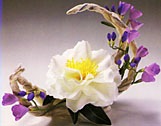
THE
HISTORY OF
BOEHM STUDIOS

![]() he
Boehm Studios have joined a long list of illustrious international
porcelain names that have passed through an ancient history that
reaches back 2,000 years. The studios' name derived from its talented
founder, Edward Marshall Boehm, who died in 1969. Since then,
it has been carried forward by his wife and business partner,
Helen Boehm, and a skilled staff of dedicated artists and craftsmen.
he
Boehm Studios have joined a long list of illustrious international
porcelain names that have passed through an ancient history that
reaches back 2,000 years. The studios' name derived from its talented
founder, Edward Marshall Boehm, who died in 1969. Since then,
it has been carried forward by his wife and business partner,
Helen Boehm, and a skilled staff of dedicated artists and craftsmen.
In 1950, Edward and Helen Boehm started a basement studio in Trenton, New Jersey, ceramic center of our country since the middle of the last century. Neither was trained in the disciplines of porcelain making. Edward Boehm knew nothing about ceramics and had little formal art education. Helen Boehm was not trained for the marketing and promotional challenges which lay ahead of her.
What makes the success of Boehm all the more remarkable is that most of the fine porcelain artists of history worked with established studios (some of them subsidized) and concentrated primarily on the creative work, the sculptural prototypes. Supporting staffs were present and skilled, qualities and formulas tested and established, reputations well-known, markets oriented.
When the Boehms started their studio, Edward Boehm, the naturalist-farmer, had only an innate talent as a sculptor and craftsman, which was joined with an intense desire to excel in any endeavor he attempted. Helen Boehm was the perfect complement, a dynamic, energetic, natural tactician whose inexperience often proved to be an asset. It was she who forged brilliant promotional and marketing concepts during the first few years, when immediate acceptance was necessary if the studio was to survive.
Photo Credit: Swan Lake Camellia with Feesia
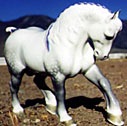
 part
from the raw genius and enormous talent, how did Boehm gain recognition
so quickly? By endorsements of museum curators, connoisseurs of
fine porcelain, and public luminaries. As early as January 1951,
The Metropolitan Museum of Art acquired two of Mr. Boehm's first
sculptures, a Percheron Stallion and Hereford Bull. Vincent Andrus,
then curator of the American Wing, described the porcelains to
the New York Times as "equal to the finest of superior English
work." Other museums took notice of Boehm, as did fine galleries
and collectors.
part
from the raw genius and enormous talent, how did Boehm gain recognition
so quickly? By endorsements of museum curators, connoisseurs of
fine porcelain, and public luminaries. As early as January 1951,
The Metropolitan Museum of Art acquired two of Mr. Boehm's first
sculptures, a Percheron Stallion and Hereford Bull. Vincent Andrus,
then curator of the American Wing, described the porcelains to
the New York Times as "equal to the finest of superior English
work." Other museums took notice of Boehm, as did fine galleries
and collectors.
By the end of the decade, Boehm was represented in 11 other museums including Buckingham Palace, Elysee Palace and The Vatican. Today the porcelains are in over 100 museums and institutions throughout the world.
Photo Credit: Percheron Stallion,
owned by Karen Grimm.
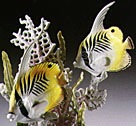
![]() arly
in 1953, President and Mrs. Eisenhower recognized the art and
began to utilize it for gifts to visiting Heads of State, culminating
in the sculpture "Prince Philip on His Polo Pony" presented
to the Queen and Prince when they visited the United States in
1957. Every American President since has commissioned Boehm for
gifts to visiting dignitaries.
arly
in 1953, President and Mrs. Eisenhower recognized the art and
began to utilize it for gifts to visiting Heads of State, culminating
in the sculpture "Prince Philip on His Polo Pony" presented
to the Queen and Prince when they visited the United States in
1957. Every American President since has commissioned Boehm for
gifts to visiting dignitaries.
In 1959, His Late Holiness Pope John XXIII was presented with several pieces for The Vatican Museum, including the sculpture "Cerulean Warblers with Wild Roses." On viewing it for the first time, he exclaimed, "One hesitates to go to close for fear the birds might fly away."
Photo Credit: Butterfly Fish
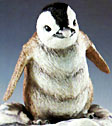 Through the 1960's
the recognition came from around the world as more people became
aware of Boehm porcelains. Perhaps the most valued attention came
from within the porcelain field itself. from the peers of Boehm.
Potters are not prone to compliment one another publicly; quite
the contrary. The history of porcelain is legend for its intrigue,
secrecy and plagiarism of talents and formulae. But even the potters
were awed by what the Boehms had accomplished. And they said so.
Through the 1960's
the recognition came from around the world as more people became
aware of Boehm porcelains. Perhaps the most valued attention came
from within the porcelain field itself. from the peers of Boehm.
Potters are not prone to compliment one another publicly; quite
the contrary. The history of porcelain is legend for its intrigue,
secrecy and plagiarism of talents and formulae. But even the potters
were awed by what the Boehms had accomplished. And they said so.
One of the most important statements was from John E. Hartill, President of the British Manufacturer's Federation 1966-1967 and Managing Director of Minton China of England. In writing an appreciation for the book "Edward Marshall Boehm, 1913-1969," published in 1970, he state, "At one memorable gathering when a superb collection of Boehm sculptures were presented to a cultural center, Edward Marshall Boehm was described at the ceramic genius of the age. In more ways than one, he has made ceramic history in the Twentieth Century; future generations will recgnize his work as an impotant contrubution to the art of our time."
Photo Credit: Baby Emperor Penguin
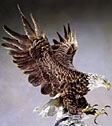
![]() hen Edward
Boehm died, it was assumed by many that the studio would not continue.
Helen Boehm, his most dedicated student, now had to lead the team.
Through the prior two decades of working together, they had shared
each new art concept. Helen had brought back ideas and needs from
the vast market before them. Edward utilized the information when
formulating and executing his designs. It was natural in 1969
for Helen Boehm to assume the design responsibility as well--not
directly creating the porcelains, but energizing, motivating and
orchestrating the "new" designs of the team her late
husband had formed.
hen Edward
Boehm died, it was assumed by many that the studio would not continue.
Helen Boehm, his most dedicated student, now had to lead the team.
Through the prior two decades of working together, they had shared
each new art concept. Helen had brought back ideas and needs from
the vast market before them. Edward utilized the information when
formulating and executing his designs. It was natural in 1969
for Helen Boehm to assume the design responsibility as well--not
directly creating the porcelains, but energizing, motivating and
orchestrating the "new" designs of the team her late
husband had formed.
Not only did the studio continue to flourish, it grew. But not fast enough to keep pace with an accelerating demand. In 1970, Helen Boehm decided to travel to England in hopes of establishing the first extra-national American porcelain subsidiary. It was a dream of her late husband who had high admiration for English porcelain quality. She succeeded and in just three years, Boehm of Malvern England Limited was carving its niche in the history of fine porcelain.
Through the 1970's, Boehm expanded at a measured pace, always placing qualitative considerations ahead of quantitative. Honored commissions continued to come. President Nixon placed a major Boehm collection in the Oval Office of The White House, gave sculptures to the head of all NATO countries in 1969, and on his historic trip to China in 1972, presented to Chairman Mao and the Chinese people a life-size pair of Boehm porcelain Mute Swans called "Birds of Peace."
President Ford utilized Boehm porcelains for his trips both to Russia and China and, in 1976, presented the life-size Boehm American Bald Eagle to the Smithsonian Institution.
President and Mrs. Carter used a specially designed Boehm piece for some of their gift-giving (Georgia Brown Thrashers); and Mrs. Carter was especially fond of the Malvern flowers for White House functions.
Former President Reagan and his wife have been supporters of Boehm for many years. At The White House, they had a large collection in their living quarters. The official East Wing Reception Room features 12 sculptures housed in a handsome Sheraton breakfront; the former President often gave Boehm sculptures to visiting Heads of State. (this brochure was written when Reagan was President, so there is no information about subsequent Presidents)
Photo Credit: American Bald Eagle
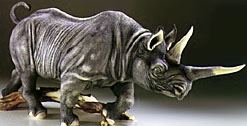
![]() he
attention received in the United States by Boehm of Trenton is
now being paralleled by Boehm of Malvern. Special gifts have been
designed for all members of the immediate Royal Family. Prince
Charles honored the studio with a memorable visit in May 1979.
On seeing a Boehm handmade rose for the first time, he marveled,
"Only the fragrance is missing."
he
attention received in the United States by Boehm of Trenton is
now being paralleled by Boehm of Malvern. Special gifts have been
designed for all members of the immediate Royal Family. Prince
Charles honored the studio with a memorable visit in May 1979.
On seeing a Boehm handmade rose for the first time, he marveled,
"Only the fragrance is missing."
In August 1980, Boehm of Malvern presented to the Queen Mother for her 80th birthday a porcelain replica of the "Rose of Glamis," a new species of rose hybridized in her honor.
Since 1981, presentations to the Royal Family have included the great Osprey sculpture to H.R.H. Prince Philip, a large floral centerpiece for the wedding of the Prince and Princess of Wales, a polo study and rhinoceros for Prince Charles, and Doves with Cherry Blossoms for Princess Diana.
Photo Credit: Black Rhinoceros

![]() he most
recent, important chapter in the Boehm experience occurred in
May and June of 1987 when Mrs. Boehm, accompanied by 185 art patrons
from 34 states, traveled to what was formerly known as the U.S.S.R.
for a Boehm exhibition in Moscow. The event had been planned with
the assistance of Dr. Armand Hammer and with the approval of the
State Department. The collection was comprised of 48 major Boehm
works, including the great Mute Swans, "Birds of Peace,"
borrowed from The White House. Madame Raisa Gorbachev and the
Soviet Ministers of Culture officially opened the six-week-long
exhibition at a black-tie reception in The Pavilion for the Management
and Protection of Nature.
he most
recent, important chapter in the Boehm experience occurred in
May and June of 1987 when Mrs. Boehm, accompanied by 185 art patrons
from 34 states, traveled to what was formerly known as the U.S.S.R.
for a Boehm exhibition in Moscow. The event had been planned with
the assistance of Dr. Armand Hammer and with the approval of the
State Department. The collection was comprised of 48 major Boehm
works, including the great Mute Swans, "Birds of Peace,"
borrowed from The White House. Madame Raisa Gorbachev and the
Soviet Ministers of Culture officially opened the six-week-long
exhibition at a black-tie reception in The Pavilion for the Management
and Protection of Nature.
Mrs. Boehm made several presentations of important works, including "Doves with Cherry Blossoms" to Mrs. Gorbachev, "Brown Bear" to the Children's Dance Institute of Moscow, and the great "American Bald Eagle," which was a gift to the citizens of Russia from the United States.
The ultimate honor occurred when our Soviet hosts decided to permanently place the eagle sculpture in the famous Hermitage Museum in Leningrad, the first American sculpture studio ever to be so honored.
Photo Credits:
Top: Global Peace, presented to General Secretary
Mikhail Gorbachev at the Summit meeting December 1987. Bottom:
Close-up of dove from Global Peace.
![]() hat
is in the future? "More of the same," states Helen Boehm.
"We are dedicated to creating as much beauty as possible
and to maintinainng Boehm of Trenton and Malvern as the worl'd
premier art porcelian studios. Birds, flowers, and animals will
always comprose the major part of our work; but occasionally we'll
test our skills and versitility with topical collections such
as our re-creations in gilded porcelain of Tutankhamun.
hat
is in the future? "More of the same," states Helen Boehm.
"We are dedicated to creating as much beauty as possible
and to maintinainng Boehm of Trenton and Malvern as the worl'd
premier art porcelian studios. Birds, flowers, and animals will
always comprose the major part of our work; but occasionally we'll
test our skills and versitility with topical collections such
as our re-creations in gilded porcelain of Tutankhamun.
What is the potential of Boehm porcelains as future heirlooms and art investments? The auction experience, which began only in 1967, has shown a substantial average appreciation in the porcelains. A replica pair of the Mute Swans (of which there were theree pairs) was acutioned by Sotheby's of London in September 1975 to benefit the World Wieldlif Fund and brought $150,000--more than three times the highest auction price of any porclain made cince the turn of the century.
For more information, you may call Boehm's toll-free number: 1-800-257-9410 for the name of the Boehm gallery nearest you; perhap you will be lucky enough to see some of these pieces in person!